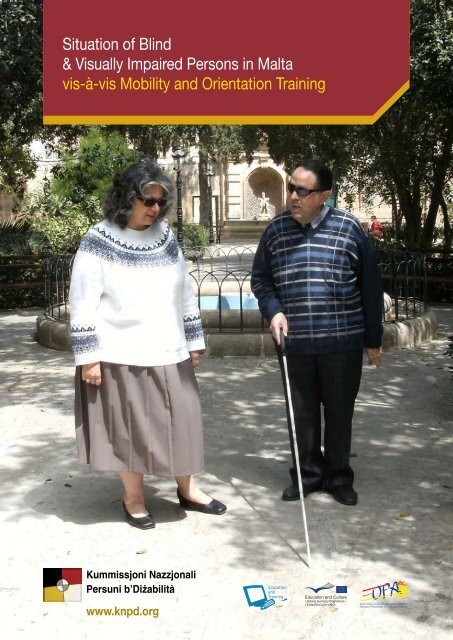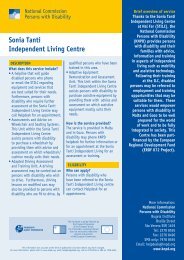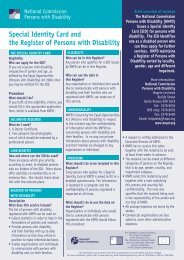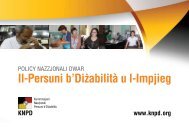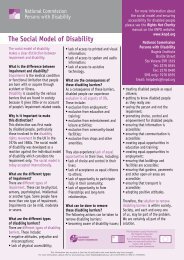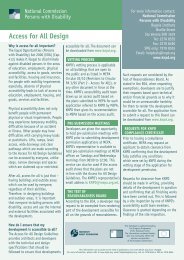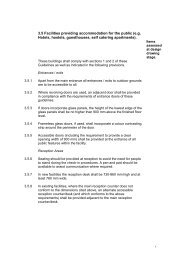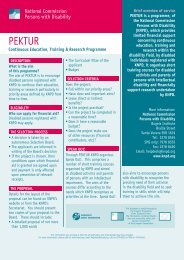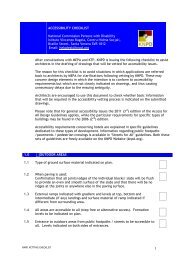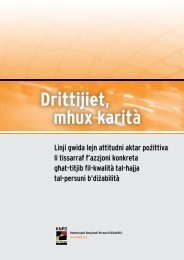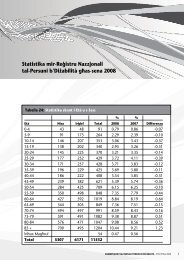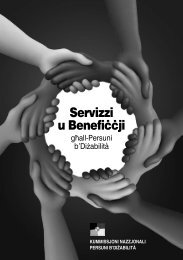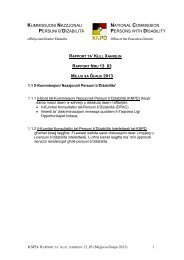KNPD visual report.pdf
KNPD visual report.pdf
KNPD visual report.pdf
Create successful ePaper yourself
Turn your PDF publications into a flip-book with our unique Google optimized e-Paper software.
Situation of Blind<br />
& Visually Impaired Persons in Malta<br />
vis-à-vis Mobility and Orientation Training<br />
Kummissjoni Nazzjonali<br />
Persuni b’DiΩabilità<br />
www.knpd.org
Editors: J Camilleri, A Zammit<br />
Publication:<br />
Kummissjoni Nazzjonali Persuni b’DiΩabilità<br />
Çentru Óidma Soçjali, Istitut Vincenzo Bugeia, Santa Venera<br />
Telephone: 2278 8555<br />
Fax: 2278 8490<br />
SMS only: 7978 8555<br />
Email: helpdesk@knpd.org<br />
www.knpd.org<br />
ISBN: 978-99909-71-46-0<br />
© Kummissjoni Nazzjonali Persuni b’DiΩabilità - 2010<br />
This publication has been funded with the support of the European Commission.<br />
This publication reflects the views only of the author, and the Commission cannot be<br />
held responsible for any use which may be made of the information contained therein.
Introduction<br />
Methodology<br />
Blind and <strong>visual</strong>ly impaired persons<br />
perceive the world differently from sighted<br />
persons. Mobility and Orientation Training<br />
(MOT) can increase the independence<br />
and quality of life of blind and <strong>visual</strong>ly<br />
impaired persons, as they would be<br />
able to participate more actively in their<br />
community. There is currently no MOT<br />
service in Malta.<br />
The Mobility and Orientation for Blind and<br />
Visually Impaired Persons (MOBAVIP)<br />
Project is a part-funded EU project aimed<br />
at transferring the innovation of MOT to<br />
the Maltese Islands. The project includes a<br />
study on the situation of blind and <strong>visual</strong>ly<br />
impaired persons vis-à-vis MOT in Malta.<br />
A questionnaire consisting of thirteen (13)<br />
questions was sent out to a representative<br />
sample of five hundred (500) individuals<br />
registered as blind or <strong>visual</strong>ly impaired<br />
persons with <strong>KNPD</strong>. The questionnaire<br />
(see appendix A) was designed by <strong>KNPD</strong><br />
with the assistance of Provision Solutions<br />
which is one of the partner organisations<br />
in the MOBAVIP project. The sample was<br />
extracted according to the gender, age<br />
and district (location) of the population<br />
of mobility and <strong>visual</strong>ly impaired persons<br />
registered in the <strong>KNPD</strong> database. Out<br />
of the five hundred (500) questionnaires<br />
sent out, hundred and thirty (130) persons<br />
completed the questionnaires. This<br />
amounts to a response rate of 26%, which<br />
is considered as an average response rate.<br />
In order to gain more information about<br />
what blind and <strong>visual</strong>ly impaired persons<br />
think and know about MOT, a questionnaire<br />
was sent out to a sample of persons<br />
registered as blind or <strong>visual</strong>ly impaired with<br />
the National Commission Persons with<br />
Disability (<strong>KNPD</strong>).<br />
3
Results and Analysis<br />
PART 1:<br />
Demographics<br />
Gender<br />
Out of 130 respondents, 64 of them,<br />
equalling to 49% of the total respondents,<br />
were men. The remaining 66 persons,<br />
that is 51% of the total respondents, were<br />
women. The difference between male and<br />
female respondents is very slight. The<br />
gender of the respondents is represented<br />
in a pie chart, Figure 1 found in Appendix<br />
B.<br />
Age<br />
• 3 out of the 130 respondents were<br />
aged between zero (0) and 9 years –<br />
2.3%.<br />
• 2 respondents were aged from 10 to 19<br />
years of age – 1.5%.<br />
• Another 2 persons were aged between<br />
20 to 29 years – 1.5%.<br />
• 15 respondents were 30 to 39 years old<br />
– 11.5%.<br />
• 20 respondents had 40 to 49 years of<br />
age – 15.4%.<br />
• 21 of the respondents were aged<br />
between 50 to 59 years old – 16.2%.<br />
• 18 respondents had 60 to 69 years of<br />
age – 13.9%.<br />
• 30 persons were between 70 to 79<br />
years old – 23.1%.<br />
• 15 were between 80 to 89 years of age<br />
– 12%.<br />
• 4 respondents were aged over 90 –<br />
3.1%.<br />
The percentages above have been worked<br />
out by age categories and this is the<br />
reason why the total of the percentages<br />
amounts to more than 100%.<br />
This information is represented in a bar<br />
chart, figure 2 found in Appendix B.<br />
The largest age group of respondents<br />
were aged between 70 to 79 years of age<br />
at 23.1% of the total respondents. The<br />
second largest category is that between<br />
50 – 59 years of age, amounting to 16.2%<br />
of the total respondents.<br />
Visual impairment is likely to increase with<br />
age. Consequently elderly persons would<br />
be more likely to require MOT.<br />
4
Education<br />
• 41.5%, (54 respondents) said that they<br />
frequented school up to primary level of<br />
education.<br />
• 37.7%, (49 respondents) said that they<br />
completed up to secondary school.<br />
• 8.5% (11 respondents) frequented<br />
post-secondary schooling.<br />
• 9.2% (12 respondents) completed<br />
tertiary education.<br />
• 3.1% (4 respondents) said that they<br />
received no education at all.<br />
The above information is represented in a<br />
bar chart, Figure 3 found in Appendix B.<br />
This shows that almost the majority of the<br />
respondents received only primary level<br />
education. The second largest category<br />
is that of persons that received up to<br />
secondary level education. Together<br />
these categories make up to 79.2% of<br />
the total respondents. Only 17.7% of the<br />
total respondents have received postsecondary<br />
or tertiary education.<br />
3.1% (4 persons) out of the total<br />
respondents claim that they never<br />
frequented school at all. Three of these<br />
respondents are aged over 78 years, but 1<br />
person who says that he never frequented<br />
school is 43 years of age.<br />
Employment<br />
• 3.1% (4 persons) said that at present<br />
they are full-time students.<br />
• 1.5% (2 persons) said that they are parttime<br />
students.<br />
• 13.9% (18 respondents) said that they<br />
are employed on a full-time basis.<br />
• 1.5% (2 persons) said they are in parttime<br />
employment.<br />
• 3.9% (5 persons) are seeking<br />
employment.<br />
• 7.7% (10 persons) are attending day<br />
centres.<br />
• 55.4% (72 persons) are retired.<br />
• 13.1% (17 persons) chose the category<br />
‘others’. Out of these 17, 10.7% said that<br />
they were housewives and the remaining<br />
2.3% said that they live in an institution.<br />
The above information is represented in a<br />
pie chart, Figure 4 found in Appendix B.<br />
The majority of the respondents, that is<br />
55.4%, are retired. The second largest<br />
category is that of full-time students. The<br />
ages of full-time students range between 3<br />
to 7 years of age, meaning that all of them<br />
are in primary education.<br />
The persons seeking employment are all<br />
aged between 32 and 57 years of age, of<br />
whom 3 are male and 2 are females.<br />
5
PART 2:<br />
What do respondents<br />
think of MOT<br />
The questions in this part were aimed at<br />
gathering information on whether blind<br />
and <strong>visual</strong>ly impaired persons in Malta are<br />
aware of what MOT is, whether they think<br />
such training would be of benefit to them,<br />
and what obstacles and needs they think<br />
should be addressed before they could<br />
engage in MOT.<br />
Question No. 5:<br />
If you have lost your sight later on in<br />
life, describe the difficulties you are<br />
encountering to travel and how these<br />
can be overcome<br />
The following question is aimed at<br />
gathering information on what are the<br />
obstacles that blind and <strong>visual</strong>ly impaired<br />
persons encounter when travelling from<br />
one place to another. The respondents<br />
mentioned a number of obstacles that<br />
hinder them when travelling. Respondents<br />
could mention more than one obstacle.<br />
• 26.2% (34 respondents) did not answer<br />
this question and did not mention any<br />
obstacles that they encounter in their<br />
everyday lives.<br />
• 0.8%, (1 respondent) said that he<br />
encounters no obstacles in going from<br />
one place to the other, claiming that<br />
the reason behind this is that he has a<br />
guide dog.<br />
• 4.6% (6 respondents) said that they<br />
never leave their house at all.<br />
• 36.9% (48 respondents) said that they<br />
never go out of their house alone and<br />
that they are always accompanied by<br />
another person when they need to go<br />
from one place to another.<br />
Of those respondents who do go out:<br />
• 18.5% (24 respondents) mentioned<br />
that streets are not accessible, in<br />
particular pavements were said to be<br />
considered as very dangerous due to<br />
the various items such as garbage bags<br />
and doorsteps in the way. This was<br />
the obstacle which was mentioned the<br />
most.<br />
• 10% (13 respondents) mentioned<br />
inaccessible public transport as an<br />
obstacle which deters them from being<br />
able to travel more independently.<br />
• 3.8% (5 respondents) said that the<br />
major obstacle encountered on the<br />
streets is traffic, as they are afraid of<br />
being run over by drivers.<br />
6
• 1.5% (2 respondents) said that not<br />
being trained in independent living skills<br />
constitutes an obstacle which deters<br />
them from being able to live a more<br />
independent life.<br />
The data above shows that most people<br />
do not leave their house unaccompanied<br />
and those who do go out and about do so<br />
with a number of difficulties.<br />
Question No. 6:<br />
Have you received any form of Mobility<br />
and Orientation Training in the past<br />
The respondents were asked whether they<br />
had received any form of MOT in the past.<br />
This question was aimed at gathering<br />
information on whether blind and <strong>visual</strong>ly<br />
impaired persons in Malta have received<br />
this kind of training in their life.<br />
Question No. 7:<br />
If you have received such training,<br />
which institution was providing it<br />
Those respondents who had answered<br />
yes to the previous question were asked<br />
to state which institution had provided the<br />
training in mobility and orientation.<br />
3 out of the 5 respondents who received<br />
MOT had done so in the United Kingdom.<br />
1 respondent said that he received some<br />
form of orientation training in a multisensory<br />
room at the Park of Friendship in<br />
Malta, while another respondent said that<br />
he was trained in MOT by the Malta Guide<br />
Dog Association.<br />
This indicates that there are currently<br />
limited opportunities for MOT in Malta.<br />
96.2% (125 respondents) said that<br />
they have never received mobility and<br />
orientation training in the past.<br />
3.8% (5 respondents) said that they have<br />
received MOT.<br />
From the data above it is clear that a very<br />
small percentage of respondents have<br />
been trained in Mobility and Orientation in<br />
the past.<br />
Question No. 8:<br />
And how do you feel that this training<br />
has been of benefit to you<br />
The 5 respondents who were trained in<br />
MOT commented on the effect that this<br />
training has had on their lives. Their<br />
comments were as follows:<br />
very beneficial<br />
•<br />
given some tips for everyday life<br />
•<br />
learnt all colours and orientated<br />
•<br />
himself better<br />
7
• became more independent<br />
• one of the respondents said that<br />
she had received MOT back in the<br />
United Kingdom when she was still<br />
in primary school. However, she is<br />
now too afraid to practise in Malta<br />
and always travels accompanied by<br />
another person.<br />
MOT can therefore be very beneficial<br />
although other factors (mentioned in<br />
question no. 5) may hinder <strong>visual</strong>ly<br />
impaired persons from practising it.<br />
so that the instructor can carry out an<br />
adequate assessment according to<br />
their real needs.<br />
• 0.8% (1 respondent) said that her role<br />
would be that of participating in MOT.<br />
• 0.8% (1 respondent) said that his<br />
role would be that of ensuring that<br />
all members of a particular nongovernmental<br />
organisation in Malta<br />
received MOT.<br />
The majority of respondents are unclear<br />
about what MOT entails.<br />
Question No. 9:<br />
What do you think your role would be<br />
in Mobility and Orientation Training<br />
Respondents were asked what they think<br />
that their role in MOT would be.<br />
• 69.2% (90 respondents) did not provide<br />
an answer to this question.<br />
• 8.5% (11 respondents) said that they do<br />
not know what their role in MOT would<br />
be.<br />
• 17.7% (23 respondents) said that their<br />
role in MOT would be that of trainees.<br />
• 1.5% (2 respondents) said that their role<br />
would be that of instructors/advisors.<br />
• 1.5% (2 respondents) said that their<br />
role would be that of providing all<br />
relevant information about themselves<br />
Question No. 10:<br />
What do you need to be able to do<br />
before undertaking Mobility and<br />
Orientation training<br />
The respondents were asked whether<br />
they could think of any needs that would<br />
have to be taken into consideration<br />
before they could engage in MOT.<br />
This question was aimed at gathering<br />
information on whether blind and <strong>visual</strong>ly<br />
impaired persons perceive any needs that<br />
they would have to address before being<br />
able to engage in MOT. The respondents<br />
could mention more than one need. The<br />
following are the replies received:<br />
• 56.92% (74 respondents) gave no<br />
answer to this question.<br />
8
• 18.5% (24 respondents) said that they<br />
did not know.<br />
• 3.1% (4 respondents) replied that they<br />
had no needs that had to be addressed<br />
before they could engage in MOT, and<br />
that they would be able to start the<br />
training right away.<br />
• 3.1% (4 respondents) said that they<br />
would need to learn more about what<br />
MOT entails as they feel that they<br />
do not have enough information with<br />
regards to what MOT entails.<br />
• 3.1% (4 respondents) said that they<br />
would need to be properly assessed by<br />
a Mobility and Orientation instructor.<br />
• 1.5% (2 respondents) said that they<br />
would need a medical check up before<br />
engaging in this training.<br />
• 1.5% (2 respondents) said that they<br />
would need personal assistance so that<br />
they could participate in the training.<br />
• 3.1% (4 respondents) said that<br />
they would need to be trained in<br />
communication skills prior to begin<br />
training in Mobility and Orientation.<br />
• 3.9% (5 respondents) said that they<br />
would first need to be trained in daily<br />
living skills so that they could first<br />
acquire the skills needed to get out of<br />
the house independently.<br />
• 3.9% (5 respondents) would need<br />
transport to get to the training venue<br />
• 0.8% (1 respondent) said that he would<br />
be able to participate in such training<br />
depending on the time at which the<br />
training sessions are delivered.<br />
• 0.8% (1 respondent) said that first a<br />
blind or <strong>visual</strong>ly impaired person would<br />
need to decide that s/he wants to<br />
become independent before actually<br />
deciding to embark on MOT.<br />
The data shows that most respondents<br />
required preparation before engaging in<br />
MOT.<br />
Question No. 11:<br />
Which of these form part of mobility<br />
and orientation training<br />
Answer Yes or No.<br />
This question was put forward to the<br />
respondents in order to gain a better<br />
understanding of whether blind and<br />
<strong>visual</strong>ly impaired persons are aware of<br />
what MOT is. Respondents were asked to<br />
answer with a ‘yes’ or a ‘no’ next to each<br />
item.<br />
White cane – 68 respondents out of 130<br />
said that the white cane makes part of<br />
MOT. This means that only 52.3% of the<br />
persons actually know that the white cane<br />
is a tool used as part of MOT.<br />
9
Sighted guide – 53 respondents said<br />
that sighted guide makes part of<br />
MOT amounting to 40.8% of the total<br />
respondents. Sighted guide actually<br />
makes part of MOT. The fact that only<br />
40.8% replied that it does means that the<br />
majority of respondents do not know that<br />
sighted guide makes part of MOT.<br />
Guide dogs – 49 respondents said that<br />
using a guide dog makes part of MOT,<br />
meaning that only 37.7% think that MOT<br />
also involves guide dogs as in fact it does.<br />
The rest of the respondents do not think<br />
that guide dogs make part of MOT.<br />
Taking care of guide dog – 30<br />
respondents, that is 23.08% said that<br />
MOT involves taking care of one’s guide<br />
dog. This means that 76.9% of the<br />
respondents think that taking care of a<br />
guide dog does not make part of MOT<br />
when in fact it does.<br />
Learning Braille – this does not make part<br />
of mobility and orientation training. 21<br />
respondents said that learning Braille does<br />
make part of MOT however the majority of<br />
the respondents, that is 83.8% said that<br />
learning Braille is not part of such training.<br />
Lobbying for Better Accessibility – this is<br />
in fact considered as being part of MOT<br />
and 44 respondents (33.8%) have replied<br />
correctly. The remaining respondents<br />
(66.2%) did not think that lobbying for<br />
better accessibility actually makes part of<br />
MOT.<br />
Learning Computer – this is not<br />
considered as part of MOT. Thirty-three<br />
respondents, that is 25.4% answered<br />
incorrectly saying that learning computer<br />
does make part of MOT. The remaining 97<br />
respondents (74.6%) answered correctly<br />
saying that learning computer does not<br />
make part of MOT.<br />
Learning new ways of travelling from<br />
one place to the other – 59 respondents<br />
said that learning new ways of travelling<br />
does make part of MOT. This means that<br />
45.4% of the total respondents answered<br />
correctly by saying that learning new ways<br />
of travelling from one place to another<br />
makes part of MOT while the remaining<br />
54.6% answered incorrectly by saying that<br />
learning new ways of travelling from one<br />
place to the other does not.<br />
On the whole, the respondents did not<br />
answer correctly most of the questions.<br />
10
Question No. 12:<br />
In which area/s do you think Mobility<br />
and Orientation Training would<br />
help you<br />
Respondents were asked in which<br />
aspects of their lives they feel that MOT<br />
would assist them. The respondents could<br />
choose to mark more than one aspect.<br />
The respondents replied as follows:<br />
• Education:<br />
20.8% (27 respondents) said that MOT<br />
would help them in this aspect of their<br />
lives.<br />
• Employment:<br />
30.8% (40 respondents) said that it<br />
would help them in this aspect.<br />
• Leisure:<br />
43.1% (56 respondents) said that it<br />
would help them in this aspect.<br />
• Home:<br />
53.8% (70 respondents) said that it<br />
would help them in this aspect.<br />
• Others:<br />
4.6% (6 respondents) marked the<br />
category ‘Others’.<br />
Out of the 6 respondents who marked the<br />
category ‘Others’:<br />
• 2 said that they would find MOT helpful<br />
in sport activities.<br />
• 2 respondents said that MOT would<br />
help them in doing their shopping.<br />
• 1 respondent said that it would be of<br />
great benefit for him when travelling<br />
from one country to another.<br />
• 1 respondent marked the category<br />
‘Others’ but did not specify in what<br />
activity this kind of training would be of<br />
benefit.<br />
From the data gathered, the majority of<br />
total respondents said that MOT would<br />
be of greatest benefit while they are at<br />
home. When comparing this figure to<br />
the ages of respondents, it shows that<br />
the majority of respondents (68.2%) are<br />
aged over 50 years of age, meaning that<br />
they are most likely to be interested in the<br />
‘home’ and ‘leisure’ aspects as opposed<br />
to ‘employment’ and ‘education’.<br />
Question No. 13:<br />
What other measures need to be taken<br />
in Malta to ensure that blind persons<br />
can utilize to the maximum Mobility and<br />
Orientation Training<br />
Respondents were asked to comment<br />
on the measures that need to be taken<br />
on a national level in order for blind and<br />
<strong>visual</strong>ly impaired persons to be able to put<br />
11
MOT in practice, if such training was to be<br />
delivered:<br />
• 46 respondents (35.4%) did not think<br />
of any issues which might need to be<br />
addressed.<br />
Many respondents mentioned more<br />
than one measure.<br />
• 26 respondents (20%) said that streets<br />
need to be made more accessible<br />
in a way that blind and <strong>visual</strong>ly<br />
impaired persons can go out and<br />
about safely. The obstacles mentioned<br />
were: inconsistent paving, garbage<br />
bags left on the streets, traffic lights<br />
not equipped with audible signals,<br />
pregnant windows and electrical<br />
poles in the way. The need for more<br />
accessible streets was the most<br />
frequently mentioned comment by the<br />
respondents.<br />
• 19 respondents (14.6%) mentioned the<br />
fact that there should be more disability<br />
awareness training for sighted persons.<br />
Comments regarding this matter said<br />
that it is important that sighted persons<br />
are aware of the needs and difficulties<br />
that blind and <strong>visual</strong>ly impaired persons<br />
encounter while going out and about.<br />
• 17 respondents (13.1%) mentioned<br />
the need for more accessible public<br />
transport. Visually impaired persons<br />
commented that they find it extremely<br />
difficult to use public transport for<br />
different matters such as not being<br />
able to see the number at the front<br />
of the bus thus not knowing to which<br />
destination the bus is heading, bus<br />
drivers stopping the vehicles in the<br />
middle of the streets rather than on<br />
bus-stops next to sidewalks and not<br />
being able to determine when the bus<br />
has arrived at the destination where<br />
they want to get off the bus.<br />
• 3 respondents (2.3%) mentioned<br />
the need for better enforced traffic<br />
regulations. They recounted that they<br />
are afraid of going out unassisted as<br />
they are afraid of being run over by cars<br />
and that traffic does not stop for them<br />
to cross roads not even on pedestrian<br />
crossing.<br />
• 3 respondents (2.3%) said that in order<br />
to be able to make use of mobility and<br />
orientation training they would first<br />
need to be provided with personal<br />
assistance to get assistance in carrying<br />
out tasks at home.<br />
• 2 respondents (1.5%) said that in<br />
conjunction with MOT they would<br />
require training in daily living skills to<br />
acquire knowledge on how to carry<br />
out tasks at home independently such<br />
as doing the laundry, housekeeping,<br />
cooking and personal hygiene. Such<br />
12
daily living skills combined with mobility<br />
and orientation training would assist<br />
blind and <strong>visual</strong>ly impaired persons to<br />
lead an independent life both in and<br />
outdoors.<br />
• 3 respondents (2.3%) mentioned the<br />
fact that in order to complement MOT,<br />
Braille instruction would be needed<br />
to assist blind and <strong>visual</strong>ly impaired<br />
persons so that access to information<br />
is increased. Moreover, printed material<br />
should also be made available in<br />
Braille.<br />
• 3 respondents (2.3%) said that the<br />
number of reserved parking bays for<br />
blue badge holders should increase so<br />
that blind and <strong>visual</strong>ly impaired persons<br />
can find more assistance from their<br />
families or other persons to accompany<br />
them where they need to go.<br />
• 4 respondents (3.1%) said that blind<br />
and <strong>visual</strong>ly impaired persons should<br />
make more use of technology which<br />
plays an important role in increasing<br />
their independence by enabling them<br />
to communicate with more persons.<br />
These respondents also mentioned the<br />
fact that items for blind users should be<br />
made cheaper so that more blind and<br />
<strong>visual</strong>ly impaired persons can afford to<br />
make use of them.<br />
• 1 respondent (0.8%) mentioned the<br />
fact that banking machines should be<br />
made accessible for blind and <strong>visual</strong>ly<br />
impaired students.<br />
• 1 respondent (0.8%) said that there<br />
should be a non-governmental<br />
organisation set up by blind and<br />
<strong>visual</strong>ly impaired persons to lobby for<br />
the needs of this group of persons.<br />
• 2 respondents (1.5%) mentioned<br />
the fact that first blind and <strong>visual</strong>ly<br />
impaired persons should find the<br />
necessary support that leads them to<br />
realise that they can learn to become<br />
independent prior to embarking on<br />
any kind of training. Blind and <strong>visual</strong>ly<br />
impaired persons should want to<br />
lead an independent life but in order<br />
to arrive at such a decision they first<br />
have to be adequately supported.<br />
This would lead them to learn that<br />
notwithstanding their physical<br />
impairment there are still ways and<br />
means of leading an independent life.<br />
13
conclusion<br />
This study shows that only a slight<br />
amount of blind and <strong>visual</strong>ly impaired<br />
persons have received training in<br />
Mobility and Orientation. 96.2% have in<br />
fact never received MOT in their lives.<br />
MOT is not very well known among blind<br />
and <strong>visual</strong>ly impaired persons. Blind<br />
persons do not feel safe on Maltese<br />
streets. MOT is very important but is<br />
not enough in making blind and <strong>visual</strong>ly<br />
impaired persons go out and about. If<br />
blind and <strong>visual</strong>ly impaired persons were<br />
to be trained in MOT, a number of them<br />
might still not get out of their homes as<br />
they do not feel safe on the streets. The<br />
necessary measures should be taken<br />
so that streets are made safer and more<br />
accessible for all. A blind person who<br />
was trained in MOT when in Primary<br />
school (when she was in the UK) said<br />
that she does not practise MOT in Malta<br />
as she feels that the streets in Malta are<br />
particularly unsafe. More enforcement of<br />
traffic regulations has been suggested<br />
as a way of rendering the streets safer.<br />
Blind and <strong>visual</strong>ly impaired persons<br />
mentioned a number of obstacles that<br />
hinder them when travelling from one<br />
place to another. A significant number<br />
of respondents (36.9%) said that they<br />
never leave the house alone and when<br />
they are out of the house they are always<br />
accompanied by another person.<br />
The most mentioned obstacle (18.5%) is<br />
inaccessible streets in particular street<br />
furniture in the way, electrical poles,<br />
doorsteps, pavements which are not<br />
level and garbage bags which are left in<br />
the middle of pavements. These persons<br />
feel unsafe as they could fall and injure<br />
themselves.<br />
Inaccessible public transport was also<br />
mentioned by 10% of the respondents<br />
as an obstacle which hinders blind and<br />
<strong>visual</strong>ly impaired persons from travelling.<br />
Not being able to drive their own cars,<br />
those <strong>visual</strong>ly impaired persons who can<br />
manage to get out of their house rely on<br />
public transport to go from one place to<br />
another and therefore it follows that public<br />
transport should be made accessible so<br />
that those persons can make use of it.<br />
14
The need for disability awareness<br />
training has also been mentioned by<br />
respondents saying that sighted persons<br />
should be more aware of the needs<br />
of blind and <strong>visual</strong>ly impaired persons<br />
on the streets. Rather than disability<br />
awareness raising one should consider<br />
the need for Disability Equality Training<br />
which focuses on the rights of disabled<br />
people rather than their disability.<br />
The requirement of personal assistance<br />
was also mentioned by respondents.<br />
Personal assistance would help blind<br />
and <strong>visual</strong>ly impaired persons to be able<br />
to carry out house work. A number of<br />
respondents mentioned the requirement<br />
of blind and <strong>visual</strong>ly impaired persons<br />
to be trained in daily living skills,<br />
which skills would teach blind and<br />
<strong>visual</strong>ly impaired persons to carry out<br />
housework, how to cook and personal<br />
hygiene.<br />
A number of blind and <strong>visual</strong>ly impaired<br />
persons have mentioned the need<br />
for Braille instruction. By learning<br />
Braille, blind and <strong>visual</strong>ly impaired<br />
persons would increase their access to<br />
information. Also, the use of technology<br />
should be encouraged among blind and<br />
<strong>visual</strong>ly impaired persons such as the<br />
use of computers, internet and mobile<br />
phones which would be appropriately<br />
made for the use by blind and <strong>visual</strong>ly<br />
impaired persons. It has been suggested<br />
that such items be made cheaper so<br />
that the number of blind and <strong>visual</strong>ly<br />
impaired persons who can afford such<br />
technology increases. It has also been<br />
remarked that banking machines should<br />
be made accessible for the use by blind<br />
and <strong>visual</strong>ly impaired persons, as being<br />
able to use such machines on their own<br />
will increase the independence of blind<br />
and <strong>visual</strong>ly impaired persons.<br />
The need for more reserved parking<br />
bays has been suggested so that when<br />
blind and <strong>visual</strong>ly impaired persons are<br />
accompanied by their relatives or other<br />
persons they can park their cars.<br />
One respondent suggested that a nongovernmental<br />
organisation (NGO) is<br />
set up by blind and <strong>visual</strong>ly impaired<br />
persons. It is to be noted that at the<br />
present moment there are already<br />
approximately seven active local NGOs<br />
of and for <strong>visual</strong>ly impaired persons. In<br />
the light of this <strong>KNPD</strong> strongly feels that<br />
no new NGOs be set up in connection<br />
with <strong>visual</strong> impairment but that the<br />
existing organisations should make<br />
15
more serious efforts to combine their<br />
forces and work for mutually beneficial<br />
goals.<br />
A respondent said that before undergoing<br />
any training, blind and <strong>visual</strong>ly impaired<br />
persons should find the necessary support<br />
that leads them to realise that they can be<br />
trained and learn to live an independent<br />
life notwithstanding the fact that they are<br />
blind or <strong>visual</strong>ly impaired.<br />
MOT is important and there needs to be<br />
funding for it in conjunction with making<br />
the streets and outside environment more<br />
accessible for blind and <strong>visual</strong>ly impaired<br />
persons in Malta.<br />
16
Appendix A: Questionnaire<br />
Mobility and Orientation for Blind<br />
and Visually Impaired Persons<br />
Study: The situation of Blind and Visually Impaired Persons in Malta<br />
vis-à-vis Mobility and Orientation Training<br />
Please mark your answer with an ✗<br />
1. Gender: Male: Female:<br />
2. Age in years:<br />
3. Indicate your level of education achieved:<br />
primary<br />
secondary<br />
post-secondary tertiary<br />
5. If you have lost your sight later on<br />
in life, describe the difficulties you are<br />
encountering to travel and how these can<br />
be overcome Comments:<br />
4. Are you currently:<br />
student full time<br />
student part-time<br />
employed full time<br />
employed part-time<br />
seeking employment<br />
attending day centre<br />
retired<br />
other<br />
6. Have you received any form of Mobility<br />
and Orientation Training in the past<br />
Comments:<br />
17
7. If you have received such training,<br />
which institution was providing it<br />
Comments:<br />
8. And how do you feel that this training<br />
has been of benefit to you Comments:<br />
11. Which of these form part of mobility<br />
and orientation training Answer Yes or No.<br />
Using a white stick:<br />
Using sighted guide:<br />
Using a guide dog:<br />
Taking care of guide dog:<br />
Learning Braille:<br />
Lobbying for better accessibility:<br />
Learning how to use a computer:<br />
Learning new ways to visit friends<br />
or local amenities:<br />
9. What do you think your role would<br />
be in Mobility and Orientation Training<br />
Comments:<br />
12. In which area/s do you think Mobility<br />
and Orientation Training would help you<br />
Education/Training<br />
Employment<br />
Leisure Activities<br />
At home<br />
Other: specify:<br />
10. What do you need to be able to<br />
do before undertaking Mobility and<br />
Orientation training Comments:<br />
13. What other measures need to be taken<br />
in Malta to ensure that blind persons<br />
can utilize to the maximum Mobility and<br />
Orientation Training Comments:<br />
18
Appendix B: Graphs<br />
Figure 1. Gender of respondents<br />
Figure 2. Age of respondents<br />
30<br />
25<br />
Number of<br />
respondants<br />
20<br />
15<br />
10<br />
5<br />
Age in categories<br />
19
Figure 3. Level of Education of respondents<br />
%<br />
Level<br />
Figure 4. Economic Status of respondents<br />
Employment<br />
Kummissjoni Nazzjonali Persuni b’DiΩabilità<br />
Çentru Óidma Soçjali, Istitut Vincenzo Bugeia, Santa Venera<br />
Telephone: 2278 8555<br />
Fax: 2278 8490<br />
SMS only: 7978 8555<br />
Email: helpdesk@knpd.org<br />
20<br />
www.knpd.org


